Crutch Instructions
Medically reviewed by Drugs.com. Last updated on Jun 30, 2025.
Why do I need crutches?
Crutches are tools that provide support and balance when you walk. You may need 1 or 2 crutches to help support your body weight. You may need crutches if you had surgery or an injury that affects your ability to walk.
How do I use crutches safely?
- Support your weight with your arms and hands. Do not support your weight with your armpits. This could hurt the nerves and blood vessels that are in your armpits. Keep your elbow bent when the crutch is in place under your arm.
- Walk slowly and carefully with crutches. Go up and down stairs and ramps slowly. Stop to rest when you feel tired. Get up slowly to a sitting or standing position. This will help prevent dizziness and fainting. Use your crutches only on firm ground. Use caution when you walk on ice or snow. Wet or waxed floors and smooth cement floors can be slippery. Watch out for small rugs or cords.
- Create clear pathways between rooms in your home. You may need to move your furniture to do this.
- Keep your needed items within reach. Carry items in a bag or backpack to keep your hands free.
How do I walk with crutches?
- Place both crutches under your arms. Place your hands on the hand grips of the crutches. Place your crutches slightly in front of you.
- Position the crutches. The top of the crutches should be about 2 fingers side-by-side (about 1½ inches) below your armpits. Place your weight on your hands. The top of the crutches should not press into your armpits.
- If you have one leg that is injured, keep it off the floor by bending your knee.
- Lift the crutches and move them a step ahead of you. Put the rubber ends of the crutches firmly on the ground. Move your injured leg between the crutches and slowly bring your body forward. Shift your weight onto the crutches using your arms. Take a normal step with your uninjured leg.
- If you are using your crutches for balance, move your right foot and left crutch forward. Then move your left foot and right crutch forward. Keep walking this way.
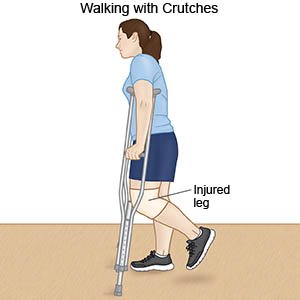
How do I go up stairs with crutches?
- Face the stairs. Put the crutches close to the first step.
- Push onto the crutches and put your uninjured leg on the first step.
- Put your weight on your uninjured leg that is on the first step. Bring both crutches and the injured leg onto the step at the same time. Make sure the rubber ends of the crutches are completely on the step.
- When you hold onto a railing with one arm, put both crutches under the other arm. Use the railing to help you go up the stairs.
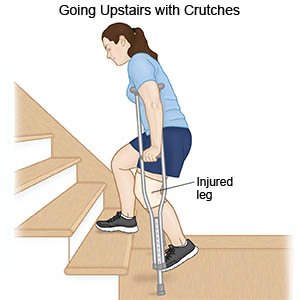
Related medications
Tylenol
Tylenol is a pain reliever and a fever reducer used to treat many conditions such as headaches ...
Paracetamol
Paracetamol (Panadol, Calpol, Alvedon) is a widely used over-the-counter painkiller and fever ...
Botox
Botox is used cosmetically to reduce facial lines and wrinkles and for medical purposes for ...
Acetaminophen/hydrocodone
The combination of hydrocodone and acetaminophen is used to relieve moderate to severe pain ...
Hydrocodone
Hydrocodone (Hysingla ER and Zohydro ER) is used for around-the-clock treatment of severe pain ...
Oxycodone
Oxycodone is an opioid analgesic used to treat moderate to severe pain; it has a high potential for ...
Qutenza
Qutenza patches are used to treat neuropathic pain associated with postherpetic neuralgia and ...
Methylphenidate
Methylphenidate is used to treat attention deficit disorder (ADD) and attention deficit ...
Acetaminophen
Acetaminophen is a widely used pain reliever and fever reducer for conditions like headaches ...
How do I go down stairs with crutches?
- Stand with the toes of your uninjured leg close to the edge of the step.
- Bend the knee of your uninjured leg. Slowly lower both crutches along with the injured leg onto the next step.
- Lean on your crutches. Slowly lower your uninjured leg onto the same step.
- Place both crutches under one arm while you hold onto the railing with the other arm.
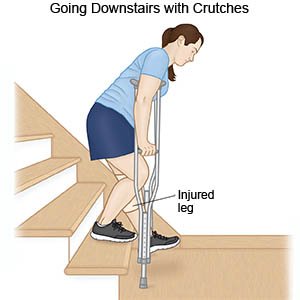
How do I sit in a chair with crutches?
- Make sure the chair is sturdy and will not move. Turn and back up to the chair until you feel the edge of it against the backs of your legs. Keep your injured leg forward.
- Hold both crutches with one hand. Use your other hand to reach back and hold on to the chair. Slowly lower your body to the chair.
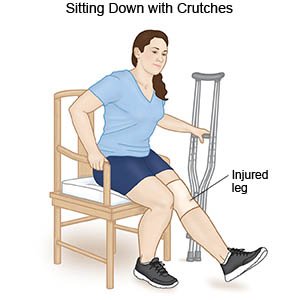
How do I get up from a chair with crutches?
- Sit on the edge of your chair.
- Push up with your hands using the crutches or arms of the chair. Put your weight on your uninjured foot as you get up.
- Keep your injured leg bent at the knee and off the floor.
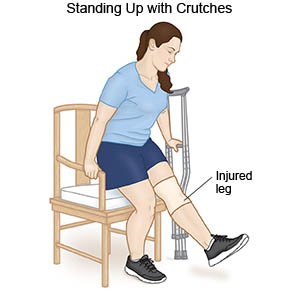
When should I seek immediate care?
- You have sudden numbness in a hand or arm.
- Your arm is swollen, red, and warm to the touch.
- Your fingers feel cold or have cramping pain.
When should I call my doctor?
- Your crutches do not fit.
- One crutch is longer than the other.
- Your crutches break or get lost.
- The rubber tips of your crutches are split or loose.
- You get blisters or painful calluses on your hands or armpits.
- Your armpit is red, sore, or has bumps or pimples.
- Your arm muscles get weaker the longer you use the crutches.
- You have questions or concerns about your condition or care.
Care Agreement
You have the right to help plan your care. Learn about your health condition and how it may be treated. Discuss treatment options with your healthcare providers to decide what care you want to receive. You always have the right to refuse treatment. The above information is an educational aid only. It is not intended as medical advice for individual conditions or treatments. Talk to your doctor, nurse or pharmacist before following any medical regimen to see if it is safe and effective for you.© Copyright Merative 2025 Information is for End User's use only and may not be sold, redistributed or otherwise used for commercial purposes.
Further information
Always consult your healthcare provider to ensure the information displayed on this page applies to your personal circumstances.
